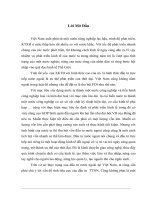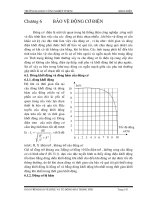6 atomsminerals
Bạn đang xem bản rút gọn của tài liệu. Xem và tải ngay bản đầy đủ của tài liệu tại đây (1.4 MB, 22 trang )
Minerals
• A mineral is a naturally occurring, inorganic,
usually non-biologic, crystalline solid, which
is physically and chemically distinctive.
• Form in the geosphere (most minerals),
hydrosphere (e.g., halite, gypsum),
biosphere (e.g., calcite, aragonite), and even
the atmosphere (e.g., water ice, as snow)
• Consistent and recognizable physical and
chemical properties
Atoms and Elements
• An element is a substance that can not be broken down into
others by ordinary chemical reactions
• An atom is the smallest unit of a substance that retains the
properties of that element
– Composed of 3 types of subatomic
particles
• Protons (positively charged)
• Neutrons (zero net charge)
• Electrons (negatively charged)
• A molecule is the smallest unit of a compound that retains the
properties of that substance: CaCO3 , FeS 2 , CaSO4 , SiO2 , K(Mg,
Fe) 3 AlSi 3 O10 (F, OH) 2
Atomic Structure
• Protons and neutrons form the nucleus
of an atom
– Represents tiny fraction of the volume at the
center of an atom, but nearly all of the mass
• Electrons orbit the nucleus in discrete
shells or energy levels
– Shells represent nearly all of the volume of
an atom, but only a tiny fraction of the mass
– Numbers of electrons and protons are equal
in a neutral atom
– Ordinary chemical reactions involve only
outermost shell (valence) electrons
Isotopes
• Atoms of an element with different numbers of
neutrons are called isotopes
• Isotopes may be either stable or unstable
– Stable isotopes retain all of their protons and
neutrons through time, (e.g. Carbon-12, Carbon-13).
These can be used to track natural processes.
– Unstable or radioactive isotopes spontaneously lose
subatomic particles from their nuclei over time,
(e.g. Carbon-14, U-238). These are sources of
radiation and heat within the Earth, and can be
used to date rocks and fossils.
Isotopes of Hydrogen
2.3
Stable isotopes of oxygen in water (ice) and shells
can be used to track climate change over time
Chemical Bonding
• Chemical bonding is controlled by
outermost shell (valence) electrons
• Elements will typically be reactive
unless their valence shell is full
• Atoms or groups of atoms with
unequal numbers of protons and
electrons, thus having a non-zero
charge, are called ions
• Positive and negative ions are
attracted to one another and may
stick or chemically bond together
Chemical Bonding
• Ionic bonding
– Involves transfer of valence
electrons from one atom to another
• Covalent bonding
– Involves sharing of valence
electrons among adjacent atoms
• Metallic bonding
– Electrons flow freely throughout
metals; results in high electrical
conductivity
Ionic bonding of NaCl (sodium chloride)
The CNO Cycle
In the high temperature condition in the
core of the high-mass stars, another
fusion process (the CNO cy cle) can
fuses hydrogen into helium at a much
faster rate than the proton-proton cycle.
• The heavier elements (carbon,
nitrogen, and oxy gen) act as
catalysis to speed up the hydrogen
fusion process
• The net result is the same as the
proton-proton chain – the creation of
a helium atom and release of energy
from fusion of four hydrogen nuclei
(protons).
• The numbers of carbon, nitrogen, and
oxygen remain the same before and
after the reaction.
Fusion Reactions in Stars to Make Heavy
Elements
Fusion of carbon into heavier elements
requires very high temperature, around 600
million degrees. There are many fusion
reactions happening in the core of the stars.
These reactions are responsible for
producing the heavy elements. The simplest
form is helium capture by heavier elements.
Fusion between heavy elements are also
possible.
• Helium Capture:
capture of helium by heavier elements
such as Carbon, Oxygen, Neon, etc…
• Heavy element fusion…
• And a whole lot more reactions…
Hydrogen and Helium abundance
reflect physics of Big Bang
Preference for even numbers
b/c of He fusion
Elements heavier than
Iron rare; formed in
nova and supernova
Relative abundance of Elements in the Universe
The 8 most common
elements in Earth’s crust
(by mass):
46.6% Oxygen (O)
27.7% Silica (Si)
8.1% Aluminum (Al)
5.0% Iron (Fe)
3.6% Calcium (Ca)
2.8% Sodium (Na)
2.6% Potassium (K)
2.1% Magnesium (Mg)
Even though there are 92 elements that are naturally found,
only eight of them are common in the rocks that make up
the Earth’s outer layer, the crust. Together, these 8
elements make up about 98% of the crust.
Composition of Earth’s
Crust
• Common elements
– Nearly 98% of the atoms in Earth’s
crust are represented by the 8 most
common elements
• O, Si, Al, Fe, Ca, Na, K, Mg
• Common mineral types
– Most minerals are silicates (contain Si
and O bonded together)
• Minerals have crystalline structures
– Regular 3-D arrangement of atoms
Silicate Structures
• The Silicon-Oxygen tetrahedron
– Strongly bonded silicate ion
– Basic structure for silicate minerals
• Sharing of O atoms in tetrahedra
– The more shared O atoms per
tetrahedron, the more complex the
silicate structure
• Isolated tetrahedra (none shared)
• Chain silicates (2 shared)
• Double-chain silicates (alternating 2
and 3 shared)
• Sheet silicates (3 shared)
• Framework silicates (4 shared)
Garnet
Augite (inosilicate)
Tremolite (amphibole)
Biotite (mica)
Quartz
Feldsapr (albite)
Non-silicate Minerals
• Carbonates
– Contain CO3 in their structures (e.g., calcite - CaCO 3)
• Sulfates
– Contain SO4 in their structures (e.g., gypsum - CaSO 4. 2H2O)
• Sulfides
– Contain S (but no O) in their structures (e.g., pyrite - FeS 2)
• Oxides
– Contain O, but not bonded to Si, C or S (e.g., hematite - Fe 2O3)
• Native elements
– Composed entirely of one element (e.g., diamond - C; gold - Au)
Minerals
• A mineral must meet the following criteria:
– Crystalline solid
• Atoms are arranged in a consistent and orderly geometric pattern
– Forms through natural geological processes
– Has a specific chemical composition
• May include some internal compositional variation,
solution of Ca and Na in plagioclase)
such as the solid
• Rock-forming minerals
– Although over 4000 minerals have been identified, only a few hundred are
common enough to be generally important to geology (rock-forming
minerals)
– Over 90% of Earth’s crust is composed of minerals from only 5 groups
(feldspars, pyroxenes, amphiboles, micas, quartz)
Minerals
• Ore minerals
– Minerals of commercial value
– Most are non-silicates (primary source of metals)
• Examples: magnetite and hematite (iron), chalcopyrite (copper), galena (lead),
sphalerite (zinc)
– Must be able to be extracted profitably to be considered current resources
• Gemstones
– Prized for their beauty
and (often) hardness
– May be commercially useful
• Diamond, corundum, garnet, and
quartz are used as abrasives
Mineral Properties
• Physical and chemical properties of minerals are closely
linked to their atomic structures and compositions
• Color
– Visible hue of a mineral
• Streak
– Color left behind when mineral is
scraped on unglazed porcelain
• Luster
– Manner in which light reflects off
surface of a mineral
• Hardness
– Scratch-resistance
• Crystal form
– External geometric form
Mineral Properties
• Cleavage
– Breakage along flat planes
• Fracture
– Irregular breakage
• Specific gravity
– Density relative to that of water
• Magnetism
– Attracted to magnet
• Chemical reaction
– Calcite fizzes in dilute HCl
Crystal Habit
appearance in hand
specimens
Massive, Granular, Compact
find grained
Lamellar, Micaceous, Bladed
layered
Fibrous, Acicular, Radiating
needlelike
Dendritic
branching
Banded, Concentric, Geodes
bands
Botryoidal, Globular, Stalactitic
orbs etc.
Oölitic, Pisolitic
pea like








